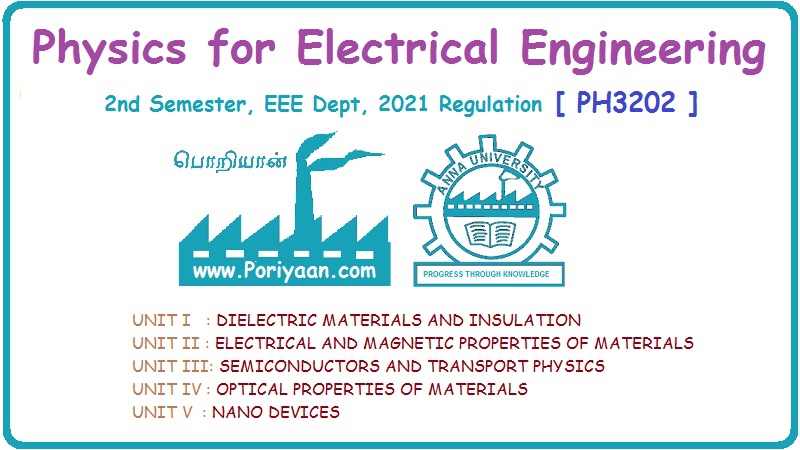Physics for Electrical Engineering: Unit V: Nano Devices
Spintronics devices and applications
Nano Devices
Spintronics is the abbreviation of spin transport electronics, also known as spin electronics. Magneto electronics, Spin Electronics and Spintronics are different name for the use of electrons' spins (not just their electrical charge) in information circuits.
SPINTRONICS DEVICES AND APPLICATIONS
Conventional
electronic devices rely on the transport of electrical charge carriers -
electrons.
The
'spin' of the electron can be used rather than its charge to create a
remarkable new generation of 'spintronic' devices. These are smaller,
more versatile and more
It
is a field of a nanotechnology that deals with spin dependent properties of
electrons and its implication in the device applications.
Spintronics
is the abbreviation of spin transport electronics, also known as
spin electronics. Magneto electronics, Spin Electronics and Spintronics are
different name for the use of electrons' spins (not just their electrical
charge) in information circuits.
Principle
All
spintronic devices act according to the simple scheme.
1.
Information is stored (written) into spins as a particular spin orientation (up
or down). (Fig. 5.23)
2.
The spins, being associated to mobile electrons, carry the information along a
wire.
3.
The information is read at a terminal.
Spin
orientation of conduction electrons survives for a relatively long time
(nanoseconds, compared to tens of femtoseconds during which electron momentum
decays).
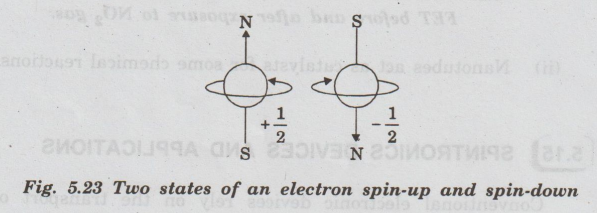
This
makes spintronic devices particularly attractive for memory storage and
magnetic sensor applications, and potentially for quantum computing.
The
electron spin will represent a bit (called qubit) of information in quantum
computing.
Since
the advent of spintronics our view of future electronic devices and
functionalities have significantly changed.
Spintronics
links the conventional microelectronic functionality of semiconductor building
blocks to the nonvolatility of magnetic building blocks.
Spintronics devices
Spin
valve
A
spin valve is a device which provides the Giant Magneto resistive effect. The
device can be made to be highly resistive or highly conductive depending on the
direction of the applied magnetic fields in the conducting layers. This
technology offers very fast switching speeds and reduced power consumption.
(Fig. 5.24)
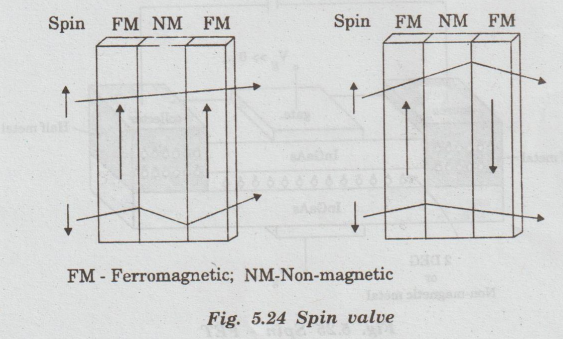
Spin
FET
A
spin based Field Effect Transistor ie., SPIN-FET structure is shown in fig
5.25.
For
functioning of this device, first the spins have to be injected from source
into the non-magnetic layer and then transmitted to the collector.
The
injected spins which are transmitted through this layer start precessing as
illustrated in fig 5:25, before they reach the collector due to the spin-orbit
coupling effect.
Hence,
the net spin polarization is reduced. In order to solve this problem an
electrical field is applied perpendicularly to the plane of the film by
depositing a gate electrode on the top to reduce the spin-orbit coupling
effect.
In
fig. 5.25 V, is the gate voltage. When V, is zero the injected spins which are
transmitted through the 2DEG (2-Dimensional Electron Gas) layer starts
precessing before they reach the collector, thereby reducing the net spin
polarization.
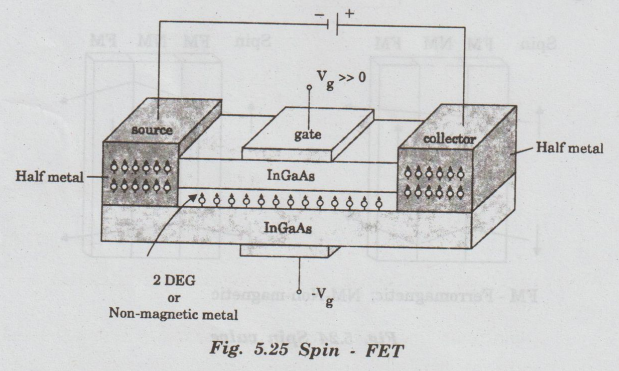
When
Vg >> 0 the precession of the electrons is controlled with
electrical filed thereby allowing the spins to reach at the collector with the
same polarization.
By
controlling the gate voltage and polarity, the current in the collector can be
modulated just like the MOSFET of the conventional electronics.
Spin
LED
In
spin LEDs the emitted light possess a polarization dependent on the spin
polarization of the charge carriers involved in the recombination. Due to this
spin-dependent polarization, a device such as a spin LED can be used to produce
light of a specific polarization. Additionally, spin LEDs can be used in the
study and development of other spintronics devices. (Fig. 5.26)
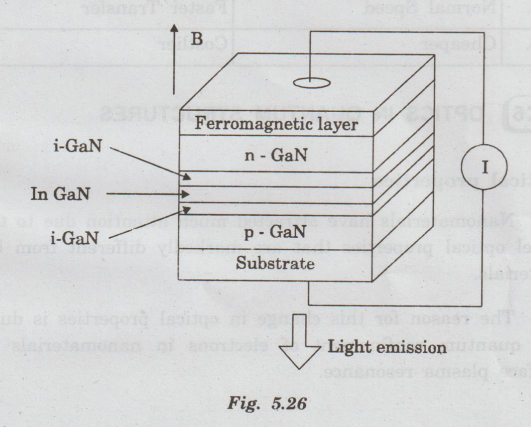
Advantages
of spintronic devices over conventional electronic devices
•
Spintronic devices are new logic devices which enhances functionality, high
speed and reduced power consumption.
•
Also ultimate miniaturization is possible with less power dissipation
Electronics
Vs Spintronics
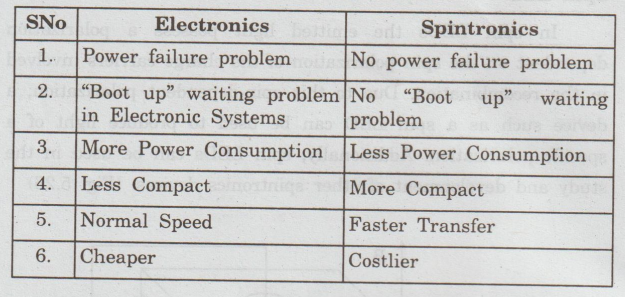
Physics for Electrical Engineering: Unit V: Nano Devices : Tag: : Nano Devices - Spintronics devices and applications
Related Topics
Related Subjects
Physics for Electrical Engineering
PH3202 2nd Semester 2021 Regulation | 2nd Semester EEE Dept 2021 Regulation
